Choosing the right database system is crucial for modern businesses that increasingly rely on data for decision-making and innovation. But which option is better?
In this post, we'll explore the differences between low-code and pro-code database systems, discussing their strengths, weaknesses, and suitability for different projects to help you make an informed decision.
We'll buid your first application for you. At no extra cost.
Let us build your first business application for free. Go from an idea to an application in under 2 weeks.

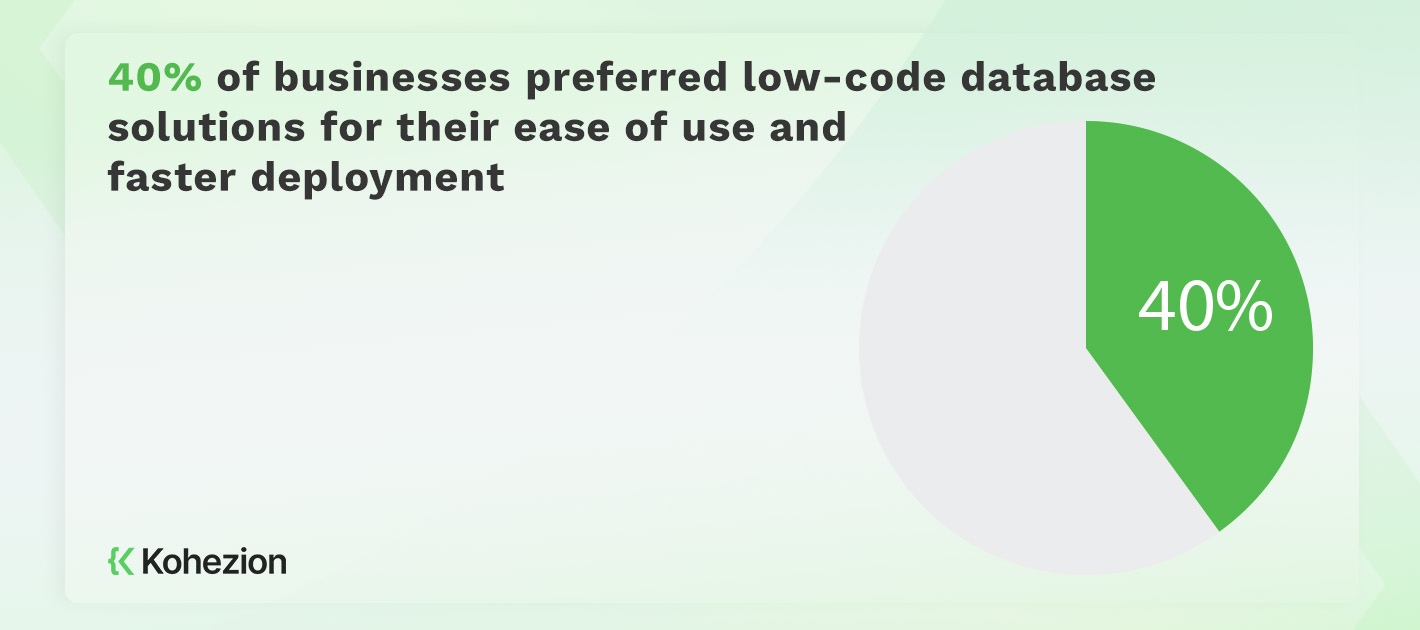
What is a Low-Code Relational Database System?
A low-code relational database system is a software tool that makes database creation and management more accessible. Its visual development interface allows you to create and manipulate databases via drag-and-drop actions, bypassing the complexities of traditional coding.
These systems excel in rapid application prototyping and deployment, reducing the time from concept to execution, which is appealing to business users and citizen developers. Integration with external systems and APIs is typically seamless, thanks to the automatic generation of SQL code that connects your data and the applications that bring them to life.
Low-code platforms make the database management process accessible to everyone, empowering you to create customized web-based apps with little to no background in programming. They provide the tools to develop forms, workflows, and reports with ease, enabling a quick response to changing business needs.
Adopting a low-code relational database means more speed, simplicity, and an inclusive development atmosphere. However, these systems may have limitations when it comes to the extremities of customization and control that some databases demand.
What is a Pro-Code Relational Database System?
A pro-code relational database system is fundamental to traditional database management, offering the highest level of precision and control. These systems are tailored for developers and organizations with specific, complex, and large-scale data requirements, providing a platform for meticulously designing and sculpting data structures using programming languages such as SQL, Python, or Java.
Pro-code systems enable the creation of custom data types, intricate relationships, and business logic that closely align with your organization's operations. You're not limited by templates or pre-defined workflows. Instead, each element of the database is fully customizable, making it possible to build powerful, enterprise-level applications.
Pro-code databases often employ advanced data structures such as B-trees, which optimize data retrieval and storage for complex hierarchies and large volumes of data. This ensures efficient performance even as your data architecture grows in complexity and size. Moreover, these systems facilitate the creation of robust data security frameworks, intricate transactions, and dependable backup mechanisms essential for critical business operations.
Choosing the pro-code route means investing in scalability, advanced functionality, and performance. However, it requires a significant level of expertise and understanding of database architecture, which can present a higher barrier to entry compared to low-code alternatives.
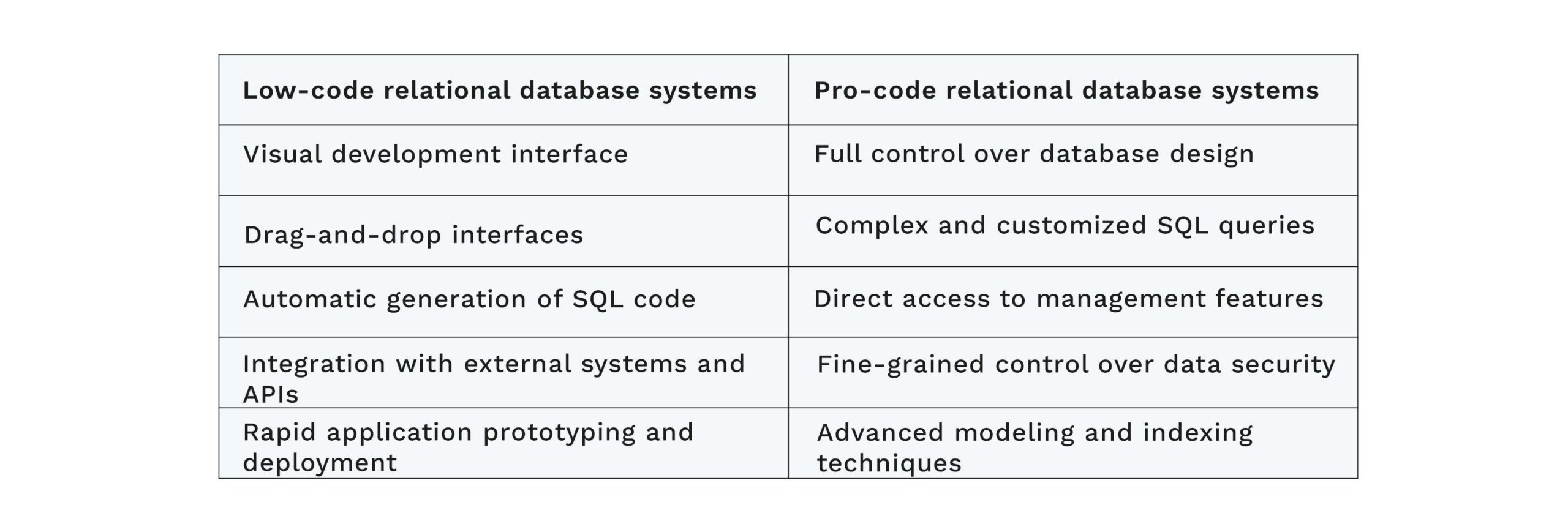
Which option is better suited for your business needs? When choosing between these database systems, consider these factors:
- User data access
- Data structure
- Data types
- Data security
- Queries
- Data storage
- Availability
- Scalability
- Flexibility
- Data integration
- User interface
- Open-source
- Application distribution
- Deployment
1. User Data Access
Non-technical individuals can develop and manage databases using low-code relational database systems without a deep understanding of coding. These systems frequently offer drag-and-drop interfaces and pre-built templates to make the process simpler. However, the degree to which users can customize their experience and access data might be restricted.
Pro-code relational database systems, on the other hand, require more technical expertise to use. These systems provide greater control over data access and customization options, though. As a user, you would be able to write your own queries.
Plus, you can have more flexibility in defining access patterns and building custom responses. Keep in mind that these systems may have a steeper learning curve and may require more time and resources to set up and maintain.
Ultimately, your choice between low-code and pro-code systems will largely depend on your technical expertise as well as the level of control and customization needed for your specific use case.
2. Data Structure
Relational database systems that employ low-code and those that use pro-code have different approaches to data structuring. They also give users varying degrees of control.
Low-code systems provide a visual interface with templates for common data structures. It’s typically a table-based structure consisting of rows and columns, where each row represents a record and each column represents a specific data attribute. So, they may not offer the same level of performance or scalability as pro-code systems.
On the contrary, pro-code systems let users customize data types and relationships, allowing them to define complex business rules and workflows. They typically rely on a data structure called the B-tree, which is a balanced tree structure optimized for efficient storage and retrieval of data in a hierarchical manner. This level of control is perfect for enterprise-level applications and highly specialized use cases where data structure and performance are vital.
3. Data Types
Relational databases, used in both low-code and pro-code systems, support a wide variety of data types. Still, the most commonly used data types are character strings (VARCHAR), integers (INT), and dates (DATE).
- Character strings are used for storing text data and have a variable length, which makes them useful for fields like names and addresses.
- Integers are used for storing whole numbers, such as IDs and quantities.
- Dates are used for storing date and time info, such as order dates and delivery times.
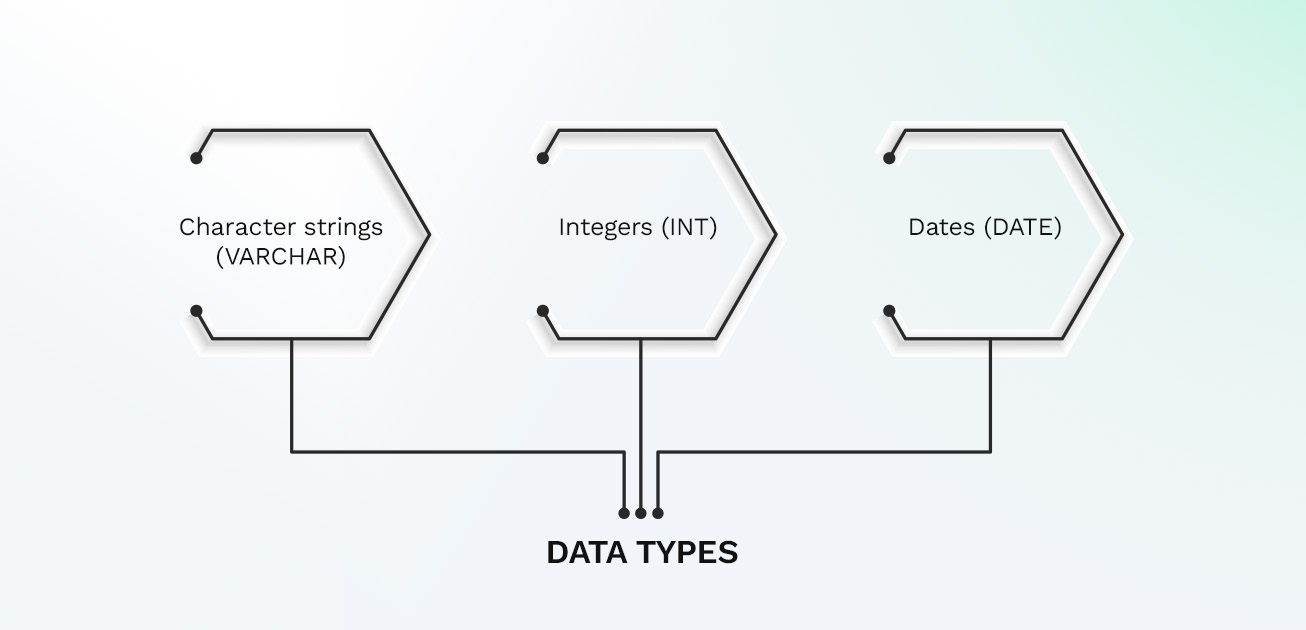
Each data type has its pros and cons. While character strings are flexible and can store a variety of information, they may take up more space in the database. Integers are efficient and easy to search but they cannot store decimal values. While dates are useful for sorting data, they may require extra processing to manipulate.
4. Data Security
These systems offer different levels of control to developers when creating and managing databases. When evaluating the security capabilities of database software, consider features like access controls, user authentication and authorization, data encryption, and regular vulnerability testing.
For example, pro-code systems like PostgreSQL (an open-source database system) offer advanced security features like row-level security and encrypted connections. Low-code systems like Airtable (a spreadsheet-database hybrid) may have more limited security options and rely more on built-in access controls.
5. Queries
Low-code systems enable users to create queries through a visual interface. This approach allows for more efficient query creation. Nevertheless, low-code systems may not be suitable for complex queries or scenarios that require fine-tuned control over query execution.
In contrast, pro-code systems require manual coding for query creation and provide more granular control over query execution. This approach is favorable for experienced users who need precise control over query execution. Pro-code systems, however, pro-code systems might need more time and skill to build and use effectively.
6. Transactions
Relational databases, whether built with low-code or pro-code, offer transactional capabilities that ensure the integrity and consistency of data. Both systems support ACID transactions, which consist of atomicity, consistency, isolation, and durability.
- Atomicity ensures that a transaction either fully completes or doesn't occur at all.
- Consistency ensures that data written to the database is valid according to defined rules.
- Isolation determines how transaction integrity is visible to other users and systems.
- Durability guarantees that committed transactions will survive permanently.
The main difference between low-code and pro-code databases is the level of control and customization they offer.
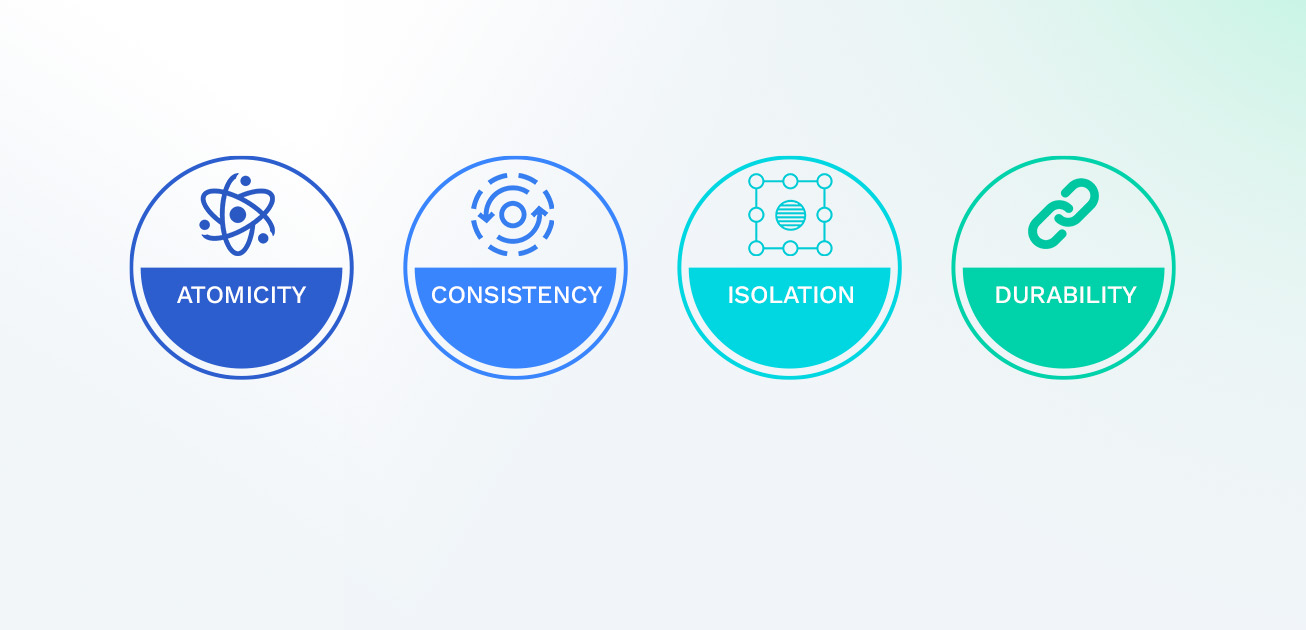
Low-code databases offer transactional capabilities that are suitable for small to medium-sized databases. However, these database systems may not be sufficient for large-scale enterprise applications. For instance, they may be used for a small e-commerce website that only requires basic transactional capabilities like adding items to a shopping cart and processing payments.
Pro-code databases offer more advanced transactional capabilities. These systems can handle complex querying options but they require more technical expertise. For instance, a pro-code database may be used for a large financial institution that requires complex transactional capabilities like handling millions of transactions per day. They also provide real-time analytics in addition to ensuring data consistency across multiple systems.
7. Data Storage
Unlike low-code systems, pro-code systems allow complex queries and advanced data manipulation. However, this comes at the cost of increased development time and a steeper learning curve.
When choosing between low-code and pro-code solutions, consider the particular requirements of your project. A low-code solution is more appropriate if you need to quickly establish a straightforward database without the need for advanced customization. A pro-code system, on the other hand, can be a better solution if you need more sophisticated data manipulation and customization features.
8. Availability
Both low-code and pro-code relational database systems are available to businesses and developers. Low-code systems are great for small businesses or non-technical users because they are user-friendly and require less technical knowledge. Yet, they may be limited in terms of customization and scalability.
Pro-code systems offer more possibilities for customization and flexibility for enterprises with more sophisticated needs. They might be more challenging to utilize, though, requiring specialized knowledge and abilities.
9. Scalability
Scalability in low-code database systems is usually limited by the platform’s built-in features and capabilities. Generally speaking, these systems aren’t capable of handling large volumes of data and/or high numbers of concurrent users. For example, Microsoft Access or Zoho Creator platforms often struggle to scale beyond a certain point due to limitations in their architecture and data processing capabilities.
Pro-code relational database systems allow more complex data modeling, indexing, and query optimization. This plays a vital role in improving scalability. Nonetheless, working with pro-code systems requires more technical expertise and development time. This can be a limitation for small teams or low-budget projects.
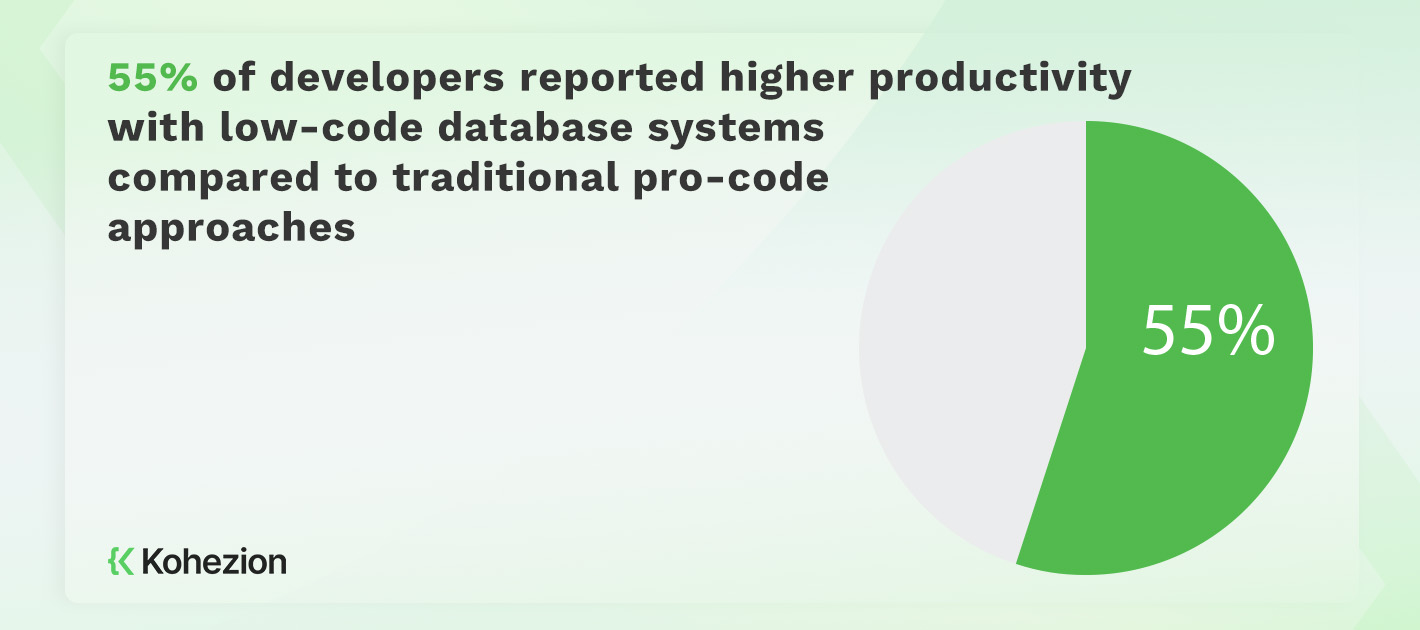
10. Flexibility
Low-code systems provide pre-built templates that can be quickly assembled to create functional applications. This approach limits the flexibility of the database because it doesn’t allow for customizations beyond the pre-built components.
Pro-code solutions provide more versatility because they permit more modification. This strategy increases the database's versatility by enabling the development of specialized components and advanced applications.
So, which one is more suitable for your business? Low-code systems are more useful for businesses that need to create straightforward applications quickly, while pro-code systems may be preferable for companies that have more sophisticated requirements. Healthcare and fintech enterprises, for example, may benefit from pro-code systems because they offer enterprise-grade security and compliance requirements.
11. Data Integration
Low-code systems enable quicker application development and deployment because non-technical users can quickly construct and edit databases without the need for developers. These systems might, however, be limited in terms of adaptability and scalability. So, they are only suitable for simple data integration.
Pro-code systems are the best choice for big projects that call for advanced data integration and processing since they provide more flexibility and customization possibilities. However, they may take longer to deploy and maintain and require a greater level of technical knowledge.
For simple data administration tasks, a small organization with few technical resources could profit from a low-code system like Microsoft Access. Contrarily, large companies with more complex data integration requirements should look for a pro-code solution like Oracle Database or IBM DB2.
12. User Interface
Most low-code relational database systems offer a user-friendly interface. So, as a non-technical user, you’ll be able to create customized web-based apps with ease. These systems enable users to build forms, workflows, and reports easily.
Pro-code relational database systems require programming knowledge to use. Their user interface includes more advanced features and customization options that allow users to develop complex applications.
13. Open-Source
Open-source database systems are software platforms providing users free access to their source code. They allow for collaborative development, customization, and redistribution of the database software.
Examples of open-source low-code database systems include Zoho Creator and Caspio. As for pro-code database systems, examples of open-source solutions include MySQL, PostgreSQL, and MongoDB.
14. Application Distribution
When it comes to application distribution, pro-code systems are better suited for large-scale projects that need custom functionality and scalability. Low-code systems are more suitable for smaller projects that need quick development and deployment.
For instance, if you run a small business and want to quickly develop a simple CRM system, consider using a low-code system. On the other hand, a large enterprise that needs to create a custom ERP that integrates with multiple applications is advised to use a pro-code system.
15. Deployment
You can deploy relational database systems using either a low-code or pro-code database system.
Low-code deployment involves using a visual interface to create and configure the database system, so it’s generally faster and easier to use. However, this approach may have limitations in terms of customization and scalability.
Pro-code deployment involves writing code to create and configure the database system. This means that you need a high level of technical expertise. This approach takes longer to deploy but it can be tailored to meet specific requirements and handle larger datasets.
Conclusion
The decision to choose between low-code and pro-code relational database systems depends on your unique business needs, technical capability, and long-term vision. Both approaches come with their own set of advantages and disadvantages.
Low-code platforms offer speed, user-friendliness, and simplicity. They lower the barrier to entry, enabling a wider range of users to participate in database development and management. This is ideal for businesses looking for agility and quick responses to market changes.
Pro-code systems, on the other hand, stand out for their depth of customization, precision, and control. They cater to more complex requirements often found in large-scale, mission-critical applications. Pro-code is the preferred choice for organizations with strong technical teams that need to push the boundaries of performance, security, and integration.
No matter what direction you choose, make sure to regularly check if your database technology matches your business goals. This ensures that your data infrastructure meets present needs and is ready for future challenges.
Start building with a free account
Frequently Asked Questions
Low-code databases prioritize simplicity and speed with a visual development interface, which is ideal for users with limited coding skills. They allow quick app prototyping and deployment but may have limited customization options. Pro-code databases require coding expertise, offering more control and extensive customization for complex applications. They are more suitable for large-scale, sophisticated projects.
Low-code systems are designed for simplicity and speed, ideal for medium to small-scale projects. They offer rapid development but they may not cater well to complex, large-scale enterprise needs because of potential limitations in customization and scalability.
Yes, transitioning from a low-code to a pro-code system is possible. However, it involves careful planning, data migration, and possibly redeveloping applications to fit the pro-code environment's technical requirements.
Choosing a low-code system generally means lower initial costs because of reduced development time and resources. Pro-code systems often incur higher costs upfront because of the requirement for specialized development expertise. However, they can be more cost-effective in the long run for complex, scalable projects.


